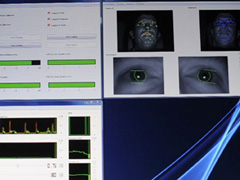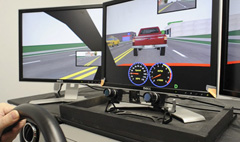UAB Researcher Tests the Limits of Distracted Driving
By Matt Windsor
If you are reading this story behind the wheel, do the rest of us a favor and put down the smartphone.
While texting, mobile browsing, and push e-mail have been a boon for chatty teens and globetrotting executives, they are just about the worst thing that has ever happened to the American roadway, says Despina Stavrinos, Ph.D., an expert on distracted driving and director of UAB’s Translational Research for Injury Prevention Laboratory, or TRIP Lab. When the information superhighway meets the real thing, wrecks are bound to occur.
Story continues below the video
Can a UAB Magazine editor—and serious multitasker—pass the distracted-driving challenge? Find out in this video.
“Over half a million drivers are injured each year due to distracted driving, and more than 6,000 people die from collisions caused by cell phone-related distractions,” says Stavrinos.
You don’t need a cell phone to practice distracted driving. Old standbys like tuning the radio or applying makeup will also take your eyes off the road. In fact, distraction is probably as old as assisted locomotion. Humans are naturally attracted by novel stimuli and bored with repetition, so we all have a tendency to take our minds off what we are doing when we’re moving around—whether it’s by horse-drawn buggy or SUV.
But you have much more room for error behind the reins of a horse than behind the wheel of a Hummer pushing 80 on an urban interstate. The range of distractions open to drivers these days is wider than ever, too—with cell phones leading the way. “Texting is particularly dangerous because it involves all three categories of distraction: You have to take your hands off the wheel, your eyes off the road, and your mind off the road as well,” Stavrinos says.
Changing Minds
Of course, it doesn’t take a Ph.D. to realize that texting is not a smart thing to do behind the wheel. But if you’re anything like the average American with a smartphone, you haven’t let that stop you. And, considering you’ve gotten away with it so far, you probably think you’re pretty good at handling distractions.
Wrong. “Everyone thinks they’re an excellent multitasker behind the wheel,” says Stavrinos. "But what we find across all studies is that everyone is impacted by distraction, regardless of age and experience."
So far, Stavrinos has administered distracted driving surveys to more than 300 teens and adults—and then put their confidence to the test in an elaborate simulator in UAB’s Edward R. Roybal Center for Research on Applied Gerontology. The simulator features three monitors displaying a wide-angle view of a three-dimensional roadway, along with an arcade-style steering wheel, accelerator, and brake pedal that are all tuned to respond just like an actual car. (That means it actually takes several seconds to accelerate from a stationary position, so teens used to videogames often report that the simulator is “slow.”)
The setup includes air conditioning (the researchers discovered that the simulation was so realistic that participants would become car sick—moving air helped with that) and an actual driver’s seat from a 1980s-vintage Honda (a donation from the center’s old simulator).
 UAB's driving simulator is equipped with eye-tracking cameras and software that can pinpoint the exact location of a subject's gaze during testing. (Virtual) Blood on the (Digital) Highway
UAB's driving simulator is equipped with eye-tracking cameras and software that can pinpoint the exact location of a subject's gaze during testing. (Virtual) Blood on the (Digital) Highway
After a few minutes of normal cruising to give participants a chance to adjust to the simulated roadway, the researchers start throwing in real-life challenges: A bicyclist veers away from the side of the road and directly in front of the oncoming car, children run out from the sidewalk, a taxi zips across several lanes from a hidden spot on the shoulder. Then the meat of the test begins as Stavrinos asks participants to place their cell phones on the car’s dash. For the next section of road, they must avoid obstacles while having a conversation with a researcher, placed outside the room to minimize any additional distraction. Then they must do the same while texting back and forth with the same researcher.
Meanwhile, a pair of cameras mounted just behind the steering wheel tracks the participant’s eyes as they dart around looking for obstacles—or fail to, as is the case when distractions mount. A nearby computer tallies the hits, near-misses, swerves, and other unsafe driving behavior, offering a second-by-second breakdown of the moving violations.
Drivers don’t usually need to see that data to know they didn’t do well. “Throughout the simulation, we hear a lot of ‘Oh my gosh, this is awful!’” Stavrinos says. Most participants emerge from the room chastened, she notes. “People are shocked by how poorly they perform. It turns out that simulation is a good teaching tool as well as a research tool.”
Big Rig Surprise
Virtual driving can produce real-world change. In one recent study, Stavrinos and her colleague and co-principal investigator Karen Heaton, Ph.D., from the UAB School of Nursing, studied commercial truck drivers using a specially designed truck-driving simulator owned by a local firm.
 Attention please: In the simulator, taxis swerve, trucks pull out suddenly, and pedestrians jaywalk flagrantly. Constant vigilance is essential to success.
“We tested their performance without distractions and while talking on cell phones, texting, and operating an on-board communication/e-mailing device” that allows drivers to communicate with their dispatchers, Stavrinos says. To the drivers’ surprise, the e-mailing device was the most distracting item in the cab. “In some ways, it was worse than texting,” Stavrinos notes. “When the drivers told their companies about the results, they changed the protocol so drivers could not operate the devices while their trucks were in motion.”
Attention please: In the simulator, taxis swerve, trucks pull out suddenly, and pedestrians jaywalk flagrantly. Constant vigilance is essential to success.
“We tested their performance without distractions and while talking on cell phones, texting, and operating an on-board communication/e-mailing device” that allows drivers to communicate with their dispatchers, Stavrinos says. To the drivers’ surprise, the e-mailing device was the most distracting item in the cab. “In some ways, it was worse than texting,” Stavrinos notes. “When the drivers told their companies about the results, they changed the protocol so drivers could not operate the devices while their trucks were in motion.”
TRIP Lab researchers are now exploring new ways to take their research on the road. Stavrinos, along with Lesley Ross, Ph.D., of the Department of Psychology, is beginning a study that will install special two-way cameras in the cars of teens and older drivers to monitor their behavior on actual roadways. Similar studies elsewhere have shown that this on-road feedback can be a powerful motivator of behavior change.
Alabama’s recent decision to ban texting and driving is very encouraging, Stavrinos says. Even though several groups have questioned the best ways to enforce the new law, she believes that driver behavior will begin to change over time. “We can use models like drunk driving laws and seatbelt laws,” Stavrinos says. “At one time, drivers would never buckle up when they got behind the wheel; now it just feels wrong not to. We’re hoping to get there with distracted driving as well.”